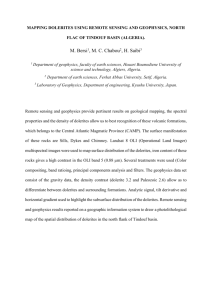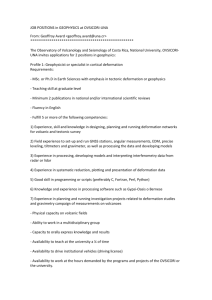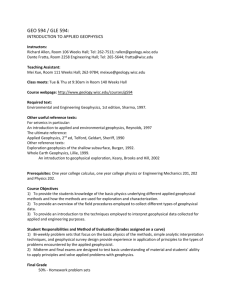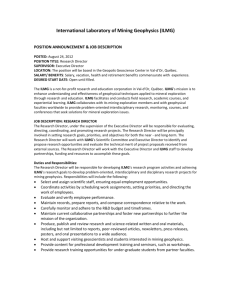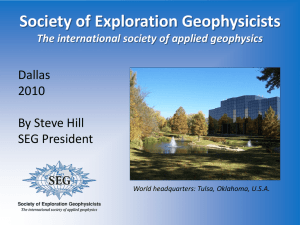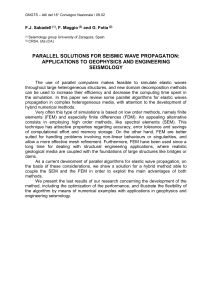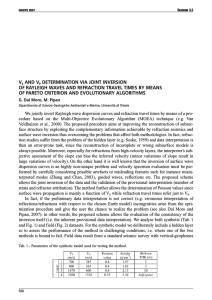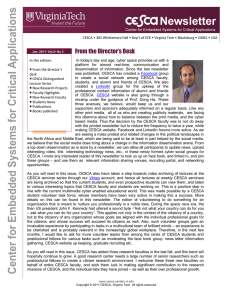Ph.D. Position in Electromagnetic Geophysics The Institute of
advertisement
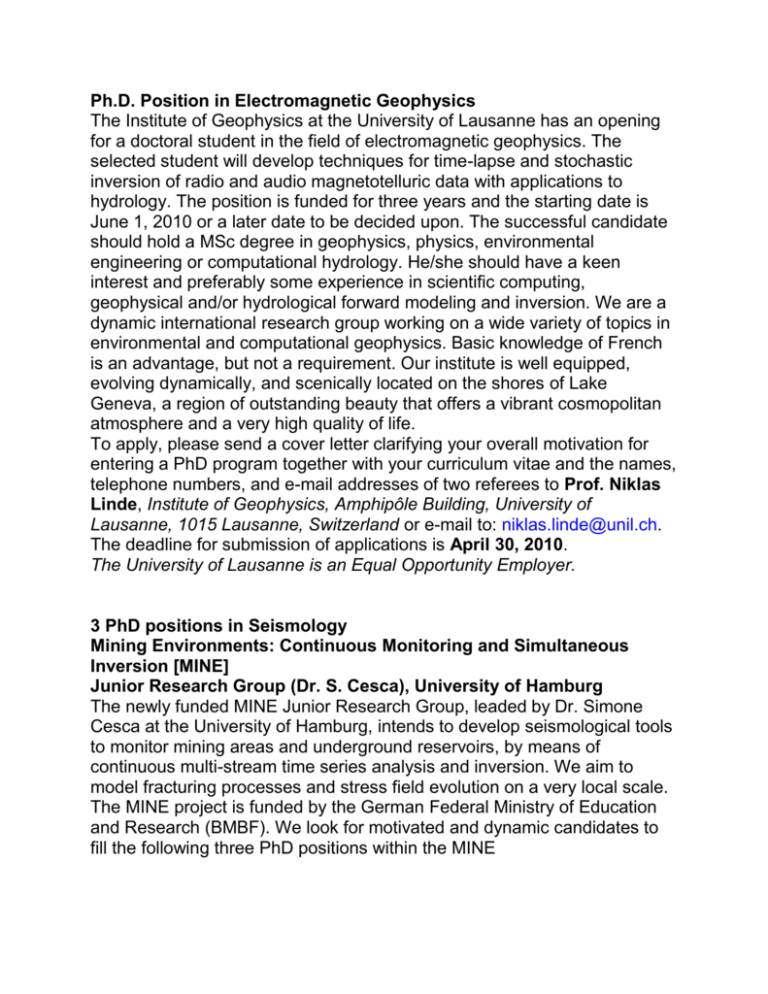
Ph.D. Position in Electromagnetic Geophysics The Institute of Geophysics at the University of Lausanne has an opening for a doctoral student in the field of electromagnetic geophysics. The selected student will develop techniques for time-lapse and stochastic inversion of radio and audio magnetotelluric data with applications to hydrology. The position is funded for three years and the starting date is June 1, 2010 or a later date to be decided upon. The successful candidate should hold a MSc degree in geophysics, physics, environmental engineering or computational hydrology. He/she should have a keen interest and preferably some experience in scientific computing, geophysical and/or hydrological forward modeling and inversion. We are a dynamic international research group working on a wide variety of topics in environmental and computational geophysics. Basic knowledge of French is an advantage, but not a requirement. Our institute is well equipped, evolving dynamically, and scenically located on the shores of Lake Geneva, a region of outstanding beauty that offers a vibrant cosmopolitan atmosphere and a very high quality of life. To apply, please send a cover letter clarifying your overall motivation for entering a PhD program together with your curriculum vitae and the names, telephone numbers, and e-mail addresses of two referees to Prof. Niklas Linde, Institute of Geophysics, Amphipôle Building, University of Lausanne, 1015 Lausanne, Switzerland or e-mail to: niklas.linde@unil.ch. The deadline for submission of applications is April 30, 2010. The University of Lausanne is an Equal Opportunity Employer. 3 PhD positions in Seismology Mining Environments: Continuous Monitoring and Simultaneous Inversion [MINE] Junior Research Group (Dr. S. Cesca), University of Hamburg The newly funded MINE Junior Research Group, leaded by Dr. Simone Cesca at the University of Hamburg, intends to develop seismological tools to monitor mining areas and underground reservoirs, by means of continuous multi-stream time series analysis and inversion. We aim to model fracturing processes and stress field evolution on a very local scale. The MINE project is funded by the German Federal Ministry of Education and Research (BMBF). We look for motivated and dynamic candidates to fill the following three PhD positions within the MINE project: PhD position (m/f) WP1 Automated event detection and location in mining environments Tasks: The main goal will be the adoption, development and validation of different techniques to detect and locate seismic sources at mines, with spatial extensions ranging from mm-length microcracks to hundred of meters rupture length of induced earthquakes. The candidate should focus specifically on the development of techniques using full waveforms and coupling different data flows (e.g. seismic, acoustic, deformation). Specific tasks will include: adoption/implementation of existing triggering and location algorithms, generalization to 3D velocity structures, development of full waveform triggering/location techniques, validation of the potential of developed techniques using synthetic datasets, application to available datasets form salt and iron ore mines, interpretation in terms of seismicity pattern evolution and relation between local seismicity and microcrack dynamics. The candidate will be responsible for the implementation of a continuous multi-stream data access interface. Strong collaboration with other work packages and partner institutions are expected. The candidate will be cosupervised by Dr. K. Stammler (BGR Hannover), where part of the research will be carried out. Qualifications: Diploma or master degree in Geophysics or Physics. Knowledge in seismology, geophysics and computer programming (Python, Fortran) will be positively evaluated. Start/duration: 1/7/2010, 3 years Salary: TV-D 13/2 PhD position (m/f) WP2 Source characterization of microseismicity Tasks: The main goal is the adoption and improvement of source inversion techniques from general seismology and their adaptation to model small-scale seismic sources at mining region. Developed techniques will make use of full waveform techniques and handle 3D velocity structures. Specific tasks will include: 3D Green's functions generation and handling, development of different inversion tools (P/S ratio and full waveform amplitude spectra inversion), moment tensor inversion in 1D and 3D models, detection of source directivity and extended source parameters, assessment of developed techniques using synthetic datasets and available datasets from different mines. The candidate will be responsible for the implementation of a multi-stream database. Strong collaboration with other work packages and partner institutions are expected. The candidate will be co-supervised by research partners at NORSAR (Norway), where part of the research will be carried out. Qualifications: Diploma or master degree in Geophysics or Physics. Knowledge in seismology, geophysics and computer programming (Python, Fortran) will be positively evaluated. Start/duration: 1/7/2010, 3 years Salary: TV-D 13/2 PhD position (m/f) WP3 Stress tomography and fracture monitoring Tasks: The final goal of this work package is to provide tools to image stress perturbations and weakening regions and their time evolution. The importance of stress tomography at mines is of extreme importance towards an efficient hazard assessment at different time scales. The main methodological aim is to develop a new method able to couple seismicity and focal mechanisms estimation, within a joint stress tomography tool. Specific tasks will include: evaluation of energy/moment release, estimation of temporal clustering properties, analysis of spatial-temporal event clustering, predictive modeling based on a stress model for specific mines, stress inversion based on seismicity rate changes, comparison of stress models based on seismicity, focal mechanisms and joint inversion, hazard assessment at different time scales. The candidate will be responsible for the implementation of the project output visualization tool. Strong collaboration with other work packages and partner institutions are expected. The candidate will be co-supervised by Dr. S. Hainzl at GFZ Potsdam, where part of the research will be carried out. Qualifications: Diploma or master degree in Geophysics or Physics. Knowledge in seismology, geophysics and computer programming (Python, Fortran, Matlab) will be positively evaluated. Start/duration: 1/7/2010, 3 years Salary: TV-D 13/2 The selection process will start on May, 15th, 2010. Later applications may be considered if the positions are not filled. The University of Hamburg is an equal opportunity employer and welcomes applications from all qualified individuals. For more information please contact Dr. Simone Cesca (simone.cesca@zmaw.de). If you wish to apply, please include a CV, a statement of research interests, and the names and contact details of two references. Applications should be directed by e-mail to: Dr. Simone Cesca Institute of Geophysics, University of Hamburg Bundesstrasse 55, D-20146 Hamburg +49.40.428384389 simone.cesca@zmaw.de The Institute of Geology invites applications for 2 PhD positions in tectonics and numerical modelling (EntgGr. (Salary Group) 13 TV-L / 50%) Description of projects One PhD project (two years with an option for extension for one year) is dedicated to the question how the seismogenic plate interface at subduction zones responds to surface processes (erosion/sedimentation, deglaciation, sea-level changes). During the project, the successful candidate will learn state-of-the-art numerical modelling techniques to evaluate the influence of surface processes on the plate interface in terms of slip patterns and earthquake frequency. She/He will apply the model results to selected natural case studies worldwide (e.g. Andes, Alaska). The other PhD project (three years) aims to investigate the impact of mass redistribution due to erosion and sedimentation on the slip evolution of individual faults. The successful candidate will learn to use an innovative numerical model that couples an advanced tectonic model including faults with a well established landscape evolution model to evaluate the potential of surface processes to influence fault behavior in different tectonic settings. The developed models will be applied to selected natural case studies worldwide (Basin-and- Range Province, Himalaya, Greece). Employment conditions Applicants must hold a diploma/MSc in geosciences and should have a strong interest in tectonics and geodynamics. Knowledge of tectonic geomorphology, numerical modelling and UNIX/Linux is beneficial but not mandatory. As an equal opportunity employer, the Leibniz Universität Hannover wishes to support women. For this reason suitably qualified women are specifically invited to apply. Equally qualified applicants with disabilities will be given preferential treatment. For further information, please contact Prof. Dr. A. Hampel (phone: 0511 / 762 2173; email: hampel@geowi.uni-hannover.de) or Dr. Georgios Maniatis (phone: 0511 / 762 17411; email: maniatis@geowi.uni-hannover.de), who will be pleased to assist. Applications will be evaluated continuously until the position is filled. Please send your application (as paper copy per mail or single PDF-file by email) including a motivation letter, CV, a statement of your research interests, copies of certificates and addresses of 2 potential referees to: Gottfried Wilhelm Leibniz Universität Hannover Prof. Dr. Andrea Hampel Institut für Geologie Callinstraße 30 30167 Hannover hampel@geowi.uni-hannover.de
